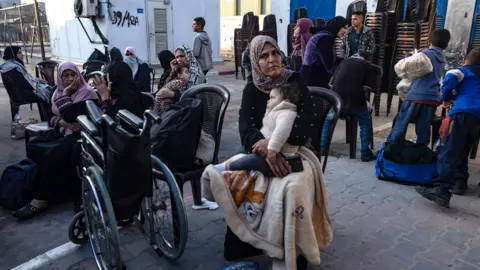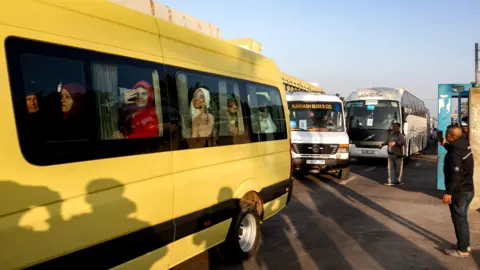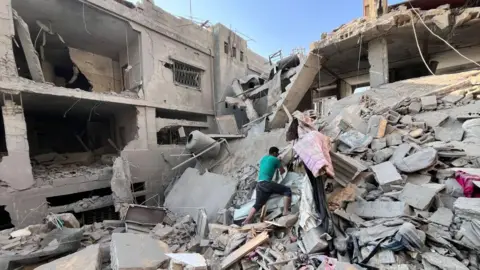 EPA
EPAMore than 200 seriously injured and ill Palestinians and their carers have been evacuated from Gaza, in one of the biggest operations of its kind in months, Israel says.
The operation – overseen by Cogat, the Israeli military body responsible for humanitarian affairs in Gaza, and the World Health Organization – saw 231 Gazans allowed through the Israeli-controlled Kerem Shalom crossing.
They include people with autoimmune diseases, blood diseases, cancer, kidney conditions and trauma injuries.
The WHO said there were still up to 14,000 people waiting for evacuation for medical reasons.
Israel and Egypt closed their crossings with Gaza following Hamas’ attack on Israel on 7 October last year.
Almost 4,900 Palestinian patients needing treatment abroad were allowed to leave between November, when Egypt reopened the Rafah crossing for medical evacuations, and May, when Egypt closed the crossing after Israeli forces seized control of the Gaza side.
Before Wednesday’s evacuation, only 229 patients had left since May, according to the UN.
 EPA
EPAWednesday also saw the WHO and Cogat announce the conclusion of the polio vaccination campaign across Gaza.
The WHO’s director general, Dr Tedros Adhanom Ghebreyesus, said 556,770 children under the age of 10 – or 94% – had received two doses of the vaccine since September.
The programme came about in reaction to the discovery of a case of polio in August, the first recorded in Gaza for 25 years.
The virus can paralyse children or even kill them. It has been the subject of a global vaccination campaign for decades and has been mostly eradicated.
On Saturday, the WHO and other UN agencies set out to administer vaccines in Gaza City, after being forced to postpone the rollout in the north of the territory last month because of Israeli bombardment, mass displacement and lack of access.
The three-day operation was briefly interrupted by an attack on a hospital. The WHO did not say who was behind the strike, but local medical staff blamed an Israeli quadcopter. The Israeli military said it was investigating but did not believe it was responsible.
Dr Tedros said 105,500 children in the north of Gaza received a second dose, which amounted to around 88% coverage. For herd immunity to work, at least 90% of all children in every community and neighbourhood need to be given a minimum of two doses.
He warned that “7,000-10,000 children couldn’t be reached for their second doses and are thus vulnerable to polio”.
Parts of northern Gaza were not included in the vaccinations due to the continuation of intense Israeli military operations in towns like Jabalia and Beit Lahia.
The Israeli Defence Forces (IDF) on Wednesday morning announced that troops had started to operate in Beit Lahia following what it said was intelligence “indicating the presence of terrorists and terrorist infrastructure”.
The IDF called on all remaining civilians to leave the area through what it called “organised routes for their safety”.
Beit Lahia has come under heavy bombardment since the IDF launched a ground offensive in neighbouring Jabalia a month ago, saying it was acting against regrouping Hamas fighters.
The IDF said its troops had killed 50 “terrorists” in Jabalia over the past day.
The BBC and other international media are not able to get access to the Gaza Strip and so cannot independently verify these claims.
 AFP
AFPThe people transported out of Gaza in the medical evacuation operation will be taken to the United Arab Emirates or Romania for treatment.
One of those being moved was Khuloud Tabasi’s son Mohammed.
Hugging her husband as she entered the ambulance in the southern city of Khan Younis, Khuloud said after four operations her son’s “situation went from bad to worse… Thank God [the WHO] organised the evacuation of my son.”
Israel has been under growing international pressure to do something to improve the humanitarian situation in the Gaza Strip.
Last weekend, 15 senior UN figures said conditions in the north were “apocalyptic”, with the entire population “at risk of death from starvation, disease and violence”.
Israel has also faced calls from its ally, the US, to take action. Secretary of State Antony Blinken warned the Israeli government on 13 October that it had 30 days to “surge” humanitarian aid to Gaza or risk having some US military assistance cut off.
The numbers still in need of medical support are huge, with 19 out of Gaza’s 36 hospitals out of service and the other 17 only partially functional.
Dr Marwan Abu Saada is general manager of the al-Shifa medical complex in Gaza City, which was left in ruins after being raided by Israeli forces for a second time in March.
The IDF said it had been used by Hamas for military purposes, something the group has always denied.
Parts of al-Shifa have now been rebuilt and reopened, including the emergency department, and the hospital recently received patients evacuated from hospitals in Beit Lahia.
Dr Abu Saada said there were children with leukaemia, people with breast and other cancers, as well as those disabled by the fighting.
“They desperately need to travel abroad as soon as possible,” he said. “Since none of the treatment facilities are available in Gaza.”
While Wednesday’s evacuation has been widely welcomed, the numbers taken to the UAE and Romania are a small fraction of the total who need medical aid.
More than that, as long as the fighting continues, the numbers in need of help will continue to grow.




